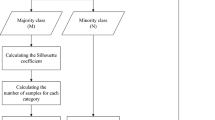Abstract
One of the most important problems in the present times is to estimate the risk in lending financial resources with respect to its returns. Credit risk can harm a lender by increasing collection costs and causing cash flow inconsistency. Lenders use credit risk modelling to assess the amount of credit risk associated with lending credit to borrowers. Financial statement analysis, default likelihood and machine learning are the options for credit risk analysis models. And, solving this kind of problem using machine learning techniques is known as credit risk modelling. In this process, we fit data having loads of features related to the financial conditions of a person into the model to classify a lender as a defaulter or non-defaulter. In this study, we used an unsupervised machine learning technique for this task. First, we applied two feature selection methods, viz. using the Pearson’s correlation coefficient and chi-square test, to select certain features which are less informative for the task. Feature selection is one of the pre-processing standards in designing advanced solutions because it does not only alleviate dataset dimensions but also improves a model’s performance measures. We also applied the fast Fourier transform (FFT) algorithm to get the discrete Fourier transform (DFT) of all the selected features, as supplementary and artificial feature vectors to the model. To deal with class imbalance, we used a specific variant of synthetic minority oversampling technique (SMOTE), i.e. Gaussian-SMOTE. Finally, we applied Gaussian mixture model (GMM) at distinct values for its parameters like the ‘covariance type’. With this and the optimally selected parameters, our methodology was able to achieve a classification accuracy of 85.48%.
Access this chapter
Tax calculation will be finalised at checkout
Purchases are for personal use only
Similar content being viewed by others
References
Arora N, Kaur PD (2020) A Bolasso based consistent feature selection enabled random forest classification algorithm: an application to credit risk assessment. Appl Soft Comput 86:105936
Wang Y et al (2020) A comparative assessment of credit risk model based on machine learning—a case study of bank loan data. Procedia Comput Sci 174:141–149
Shen F et al (2021) A new deep learning ensemble credit risk evaluation model with an improved synthetic minority oversampling technique. Appl Soft Comput 98:106852
Jadwal PK, Jain S, Agarwal B (2020) Financial credit risk evaluation model using machine learning-based approach. World Rev Entrepreneurship Manag Sustain Dev 16(6):576–589
Munkhdalai L et al (2021) A partially interpretable adaptive Softmax regression for credit scoring. Appl Sci 11(7):3227
Suhaimi NAD, Abas H (2020) A systematic literature review on supervised machine learning algorithms. PERINTIS eJ 10(1):1–24
Bhatore S, Mohan RYR (2020) Machine learning techniques for credit risk evaluation: a systematic literature review. J Bank Financ Technol 4(1):111–138
https://archive.ics.uci.edu/ml/datasets/Statlog+%28Australian+Credit+Approval%29
https://archive.ics.uci.edu/ml/datasets/Japanese+Credit+Screening
https://archive.ics.uci.edu/ml/datasets/default+of+credit+card+clients
Chawla NV et al (2002) SMOTE: synthetic minority over-sampling technique. J Artif Intell Res 16:321–357
Lee H, Kim J, Kim S (2017) Gaussian-based SMOTE algorithm for solving skewed class distributions. Int J Fuzzy Logic Intell Syst 17(4):229–234
Funding Acknowledgement
This research was supported by the IMPRESS Grants of Indian Council of Social Science and Research, Government of India.
Author information
Authors and Affiliations
Editor information
Editors and Affiliations
Rights and permissions
Copyright information
© 2022 The Author(s), under exclusive license to Springer Nature Singapore Pte Ltd.
About this paper
Cite this paper
Pandit, A.K., Vashishtha, A., Sumbria, S., Mahajan, S. (2022). An Unsupervised Learning Approach Towards Credit Risk Modelling Using DFT Features and Gaussian Mixture Models. In: Mohanty, M.N., Das, S. (eds) Advances in Intelligent Computing and Communication. Lecture Notes in Networks and Systems, vol 430. Springer, Singapore. https://doi.org/10.1007/978-981-19-0825-5_1
Download citation
DOI: https://doi.org/10.1007/978-981-19-0825-5_1
Published:
Publisher Name: Springer, Singapore
Print ISBN: 978-981-19-0824-8
Online ISBN: 978-981-19-0825-5
eBook Packages: Intelligent Technologies and RoboticsIntelligent Technologies and Robotics (R0)




